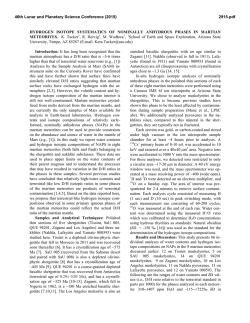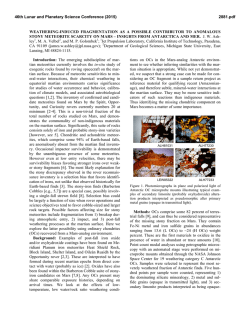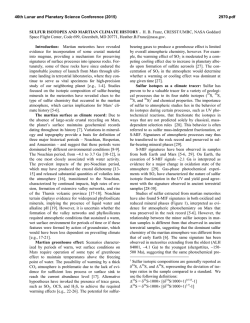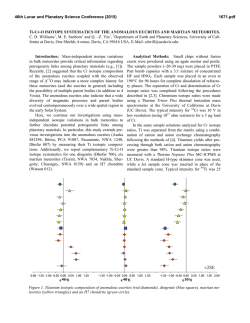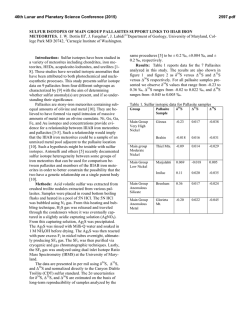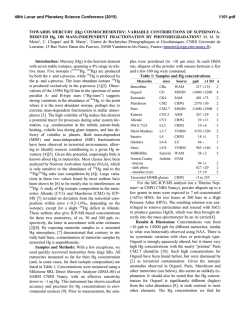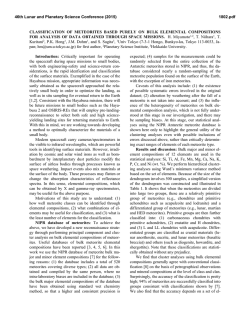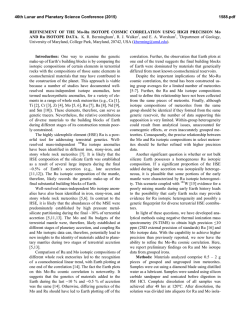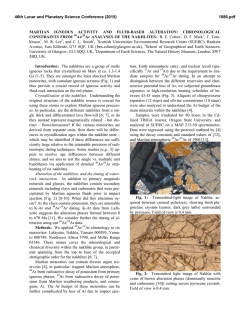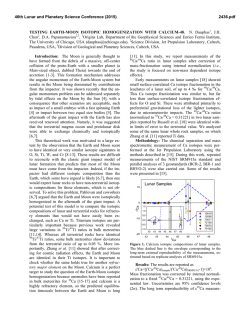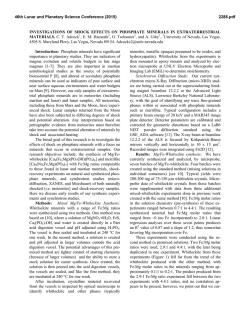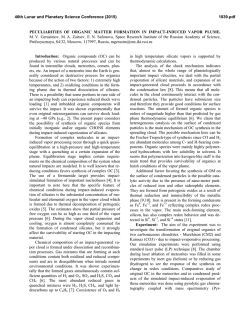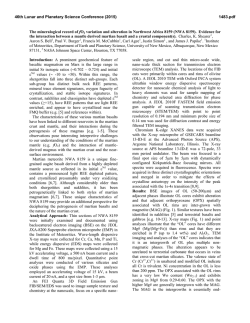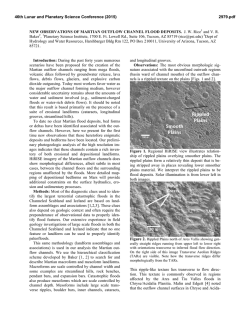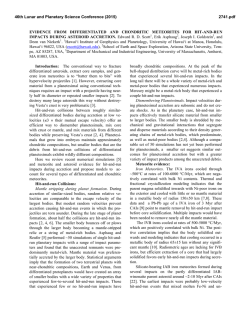
WATER IN MARTIAN METEORITES: OXYGEN ISOTOPE
46th Lunar and Planetary Science Conference (2015) 2268.pdf WATER IN MARTIAN METEORITES: OXYGEN ISOTOPE COMPOSITIONS. O. V. Maltsev1, K. Ziegler1,2, Z. D. Sharp2 and C. B. Agee1,2, 1Institute of Meteoritics, University of New Mexico, Albuquerque NM 17131, ([email protected]) 2Department of Earth & Planetary Science, University of New Mexico, Albuquerque NM 87131 Introduction: The presence of water in martian meteorites provides a unique glimpse into the evolution of water on Mars. Previous studies [1,2] have shown that the oxygen extracted from water in martian meteorites is not in isotopic equilibrium with the bulk silicate rock phases. This disequilibrium suggests that isotopically different reservoirs of oxygen exist on Mars. It has been proposed [1,2] that the mantle, lithosphere, hydrosphere and possibly the atmosphere represent isotopically distinct oxygen reservoirs on Mars, but no endmember compositions have been suggested. By analyzing the isotopic composition of oxygen in the water extracted from numerous martian meteorites it should be possible to demonstrate the presence of such different reservoirs, and possibly to link them to certain geological processes experienced by the different subgroups of martian meteorites. The goal of this work is to conduct a systematic study of the oxygen isotope composition of water in martian meteorites using a stepwise heating technique that allows extraction of water over different temperature ranges. Ultimately the study will look at a variety of shergottites, nakhlites, chassignites and the basaltic breccia NWA 7034. At present, the project is in the method development stage, and here we present our first results, the stepwise heating of the shergottite Tissint. We will present additional data from other martian meteorites at the meeting. Analytical methods: The amount of sample material needed for analysis was determined based on the wt. % water of the sample. Since martian meteorites contain between 0.03 and 0.6 wt. % water [1,2,3], sample sizes range from approximately 0.6 to 5 grams. For terrestrial control samples much less material was needed (≈0.1-0.3g) due to higher water contents. Once the appropriate amount of sample material was determined (using a TC/EA – Thermal Combustion Elemental Analyzer), the sample was crushed to a fine powder and loaded into a ½ inch diameter quartz tube. Prior to sample loading the quartz tube along with quartz wool plugs was heated to 1000°C, in order to expel any trace water contamination. Once the sample was loaded, it was flushed with ultra high purity Hegas at room temperature for two hours. The He-gas was passed through a coil of tubing held at liquid nitrogen temperature prior to entering the sample tube, in order to trap any contaminates present in the gas. The sample was then step wise heated to 50°, 200°, 400°, 700° and 1000°C. The sample was held at each temperature for 1 hour. The volatiles evolved at each in- terval were moved out of the sample tube by the He stream (at a flow rate of 120 cc/min) and collected in a cold trap held at liquid nitrogen temperature. In this study the volatiles were evolved into a helium stream instead of a vacuum as was previously done by other workers [1,2]. The use of helium was hypothesized to minimize the occurrence of secondary reactions between the evolved water and the rock sample and to minimize the large kinetic isotope effect, which favors light isotopes during the dehydration process [1]. The use of He-gas also had the beneficial effect of reducing the chance of external contamination since the sample tube was held at a positive pressure during step wise heating. After collection, the cold trap was isolated from the sample chamber and the He-gas and any other non-condensable volatiles were evacuated. The collected water was then transferred to a Ni-bomb and again frozen to liquid nitrogen temperature. BrF5 was admitted into the bomb and allowed to react for 2 hours at 300°C. This direct water-fluorination method is accepted and used by various workers [4,5]. (The extraction line described up to this point is shown in figure 1). Post fluorination, excess BrF5 was removed using a series of cold traps held at liquid nitrogen temperature and by reaction with heated NaCl. The evolved O2 gas was collected in a silica gel trap held at liquid nitrogen temperature. The O2 gas was then released from the silica trap into a He-gas carrier stream and passed through a 3-feet GC packed column (Supelco, molecular sieve 13X) kept at room temperature. This was done in order to separate the O2 from possible NF3 contamination. The purified O2 was then introduced into a Finnigan DeltaXLPlus dual inlet isotope ratio mass spectrometer and analyzed. The sample O2 was analyzed 5 to 10 times. Each analysis consisted of 20 sample-reference comparisons. Per-mil deviations in the oxygen isotopic ratios were calculated using the following expressions: δ18O={[(18O/16O)sample/(18O/16O)SMOW]-1}*103 and δ17O={[(17O/16O)sample/(17O/16O)SMOW]-1}*103 [6]. In order to create a straight-lined mass-fractionation curve the δ-values were linearized using equation: δ18/17O’=ln[(δ18/17O+1)/103]*103 [7]. Δ17O’ values were calculated using the following relationship: Δ17O’=δ17O’-0.528*δ18O’. The experimental system was evaluated for accuracy and reproducibility using a terrestrial water standard NM-2 and a terrestrial basalt sample. Fluorination of terrestrial water produced Δ17O values of 0.067 ‰ with a standard σ1 deviation of 0.018 ‰. Measurements of water extracted from ter- 46th Lunar and Planetary Science Conference (2015) 2268.pdf restrial basalt produced Δ17O values of ≈0.04 ‰ for temperatures below 450°C and Δ17O values of ≈ -0.11 ‰ for temperatures above 450°C with a standard deviation (1σ) of 0.018 ‰. This behavior appears consistent between multiple analyses of the same terrestrial basalt sample. This Δ17O anomaly observed in water extracted from terrestrial basalt at high temperature is not understood and will be further investigated. 17 Figure 2. Measured Δ O values of water extracted from Figure 1. Sampe heating furnace and sample tube (top) and Ni-bombs used to fluorinate extracted water (bottom). Results and discussion: Analysis of water extracted from Tissint shows a distinct Δ17O value relative to that of Earth (Figure 2). Water extracted at low temperature steps (0-50°C and 50-200°C) is only slightly elevated in Δ17O relative to Earth (0.06 and 0.08 ‰, respectively). It is possible that these lowtemperature waters represent absorbed terrestrial water, but given that Tissint is a fall, it is also likely that they are of martian origin. This possibility will be further investigated. Tissint water Δ17O values are most positive at temperature steps of 200-400°C and 400700°C. These waters are distinctly extraterrestrial, with values of 0.18 ‰ and 0.12 ‰, respectively. However, the measured Δ17O values from the water extracted at these temperatures fall below the Δ17O value of the whole rock silicate analysis of Tissint which is 0.295 ‰ [8]. This indicates that the oxygen in the water within Tissint is not in isotopic equilibrium with the bulk rock. The water extracted from Tissint also has a lower Δ17O value than the SNC whole rock average Δ17O value of 0.3 ‰ [9]. Similar behavior was observed in the isotopic composition of water extracted Tissint at different temperatures. from EETA79001A by Karlsson et al., (1992). Tissint and EETA79001A are both depleted picritic shergottites with similar petrologic characteristics and cosmic-ray exposure age of 0.7 ± 0.3 million years. This makes it possible that the two meteorites were ejected from Mars during the same event [10]. Therefore, it is not surprising that the two meteorites contain water with similar oxygen isotopic compositions. Karlsson et al., (1992) attributes the < 0.3 ‰ Δ17O values of water extracted from EETA79001A to terrestrial weathering and contamination. This explanation, however, is not applicable to Tissint since it was a witnessed fall and experienced minimum terrestrial contamination. Therefore, a more robust explanation for the measured Δ17O values is needed for Tissint and EETA79001A. It is possible that the isotopic signature of the water in both these meteorites was affected by the impactor responsible for the ejection of the two meteoroids [1]. Further analyses of Tissint and EETA79001A are needed to better constrain the evolution of the water within these meteorites. In order to better understand the evolution of water on the planet Mars as a whole, many more martian meteorites will be analyzed. References: [1] Karlsson et al. (1992) Science, 255, 1409-1411. [2] Agee et al. (2013) Science, 339, 780-785. [3] Leshin et al. (1996) Geochemica et Cosmochimica Acta, 60, 2635-2650. [4] Kusakabe et al. (2004) Journal of Mass Spectrometry Society Japan 52, 205-212. [5] Ahn et al. (2012) Geoscience Journal, 16, 7-16. [6] McKinney et al. (1950) Rev.Sci. Instrum., 21, 724-730. [7] Young et al. (2002) Geochimica et Cosmochimica Acta, 66, 1095-1104. [8] Ruzicka et al. (2014) The Meteoritical Bulletin, 100, 54-55. [9] Clayton and Mayeda (1983) Earth Planet. Sci. Lett. 63, 1 [10] Aoudjehane et al. (2012) Science, 338, 785-788.
© Copyright 2025
